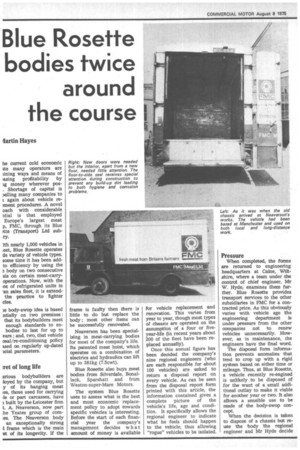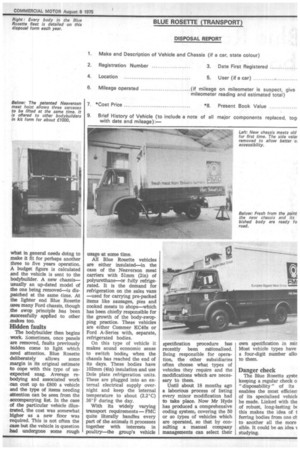Blue Rosette bodies twice around the course
Page 42

Page 43

If you've noticed an error in this article please click here to report it so we can fix it.
lartin Hayes
he current cold economic tte many operators are lining ways and means of asing profitability by lig money wherever pos. Shortage of capital is )elling many companies to again about vehicle rement procedures. A novel oach with considerable atial is that employed Europe's largest meat p, FMC, through its Blue tte (Transport) Ltd subrY.
ith nearly 1,000 vehicles in .eet,• Blue Rosette operates de variety of vehicle types. some time it has been addto efficiency by using the body on two consecutive sis on certain meat-carryoperations. Now, with the nt of refrigerated units in -an sales fleet, it is extendthe practice to Tighter cies.
te body-swop idea is based ntially on two premises : that its bodybuilders meet enough standards to embodies to last for up to ears ; and, two, that vehicle osal/re-conditioning policy ased on regularly up-dated icial parameters.
Tet of tong life
arious bodybuilders are loyed by the company, but .y of its hanging meat Les, those used for carrying de or part carcasses, have I built by the Leicester firm A. Neaverson, now part he Yeates group of comes. The Neaverson body an exceptionally strong 1 frame which is the main et of its longevity. If the frame is faulty then there is little to do but replace the body ; most other items can be successfully renovated.
Neaverson has been specialising in meat-carrying bodies for most of the company's life. Its patented meat hoist, which operates on a combination of electrics and hydraulics can lift up to 381kg (7.5mi).
Blue Rosette also buys meat bodies from Silverdale, Banallack, Sparshatt and from Weston-super-Mare Motors.
The system Blue Rosette uses to assess what is the best and most economic replacement policy to adopt towards speCific vehicles is interesting. Before the Start of each financial year the company's management decides what amount of money is available for vehicle replacement and renovation. This varies from year to year, though most types of chassis are operated on the assumption of a four or fiveyear-life (in recent years about 200 of the fleet have been replaced annually).
Once this annual figure has been decided the company's nine regional engineers (who are each responsible for about 100 vehicles) are asked to return a 'disposal report on every vehicle. As can be seen from the disposal report form printed with this article, the information contained gives a complete picture of the vehicle's life, age and condition. It specifically allows the regional engineer to indicate what he feels should happen to the vehicle, thus allowing "rogue" vehicles to be isolated.
Pressure
When completed, the forms are returned to engineering headquarters at Calne, Wiltshire, where a team under the control of chief engineer, Mr W. Hyde, examines them further. Blue Rosette provides transport services to the other subsidiaries in FMC for a contracted price. As this obviously varies with vehicle age the engineering department is under pressure from the other companies not to renew vehicles unnecessarily. However, as in maintenance, the engineers have the final word.
The disposal form information prevents anomalies that tend to crop up With a rigid system based on either time or mileage. Thus, at Blue Rosette, a vehicle recently re-engined is unlikely to be disposed of for the want of a small additional outlay to make it viable for another year or two. It also allows a sensible use to be made of the body-swop concept.
When the decision is taken to dispose of a chassis but reuse the body the regional engineer and Mr Hyde decide what in general needs tiding to make ft fit for perhaps another three to five years operation. A budget figure is calculated and the vehicle is sent to the bodybuilder. A new chassis— usually an up-dated model of the one being removed—is dispatched at the same time. At the lighter end Blue Rosette uses many Ford chassis, though the swop principle has been ,successfully applied to other makes too.
Hidden faults
The bodybuilder then begins work. Sometimes, once panels are removed, faults previously hidden come to light which need attention. Blue Rosette deliberately .allows some margin in its original estimate to cope with this type of unexpected snag Average rebodying and associated work can cost up to £800 a vehicle and the type of items needing attention can be seen from the accompanying list. In the case of the particular vehicle illustrated, the cost was somewhat higher as a new floor was required. This is not often the case but the vehicle in question had undergone some rough Usage at some time.
All Blue Rosette vehicles are either insulated—in the case of the Neaverson meat carriers with 51mm (2 in) of polyurethane—or fully refrigerated. It is the demand for refrigeration on the sales vans —used for carrying pre-packed items like sausages, pies and cooked meats to shops—Which has been chiefly responsible for the growth of the body-swopping practice. These vehicles are either Commer KC40s or Ford A-Series with, separate, refrigerated bodies.
On this type of vehicle it makes sound economic sense to switch bodies when the chassis has reached the end of its days. These bodies have 102mm (4in) insulation and use Dole plate refrigeration units. These are plugged into an external electrical supply overnight and keep the internal temperature to about (2.2°C) 36°F during the day.
With its Widely varying transport requarements —FMC quite literally handles every part of the animals it processes together with interests in poultry—the group's vehicle speCification procedure has recently been rationalised. Being responsible for operation, the other subsidiaries often choose what types of vehicles they require and the modifications which are necessary to them.
Until about 18 months ago a laborious process of listing every minor modification had to take place. Now Mr Hyde has produced a comprehensive coding system; covering the 50 or so types of vehicles which are operated, so that by consulting a manual company managements can select their own specification in mir Most vehicle types have a four-digit number allo to them.
Danger check
The Blue Rosette syste keeping a regular check o "disposability" of its enables the most efficien of its specialised vehich be made. Linked with the of robust, long-lasting bc this makes the idea of t ferring bodies from one to another all the more sible. It could be an idea ti Studying.




































































































